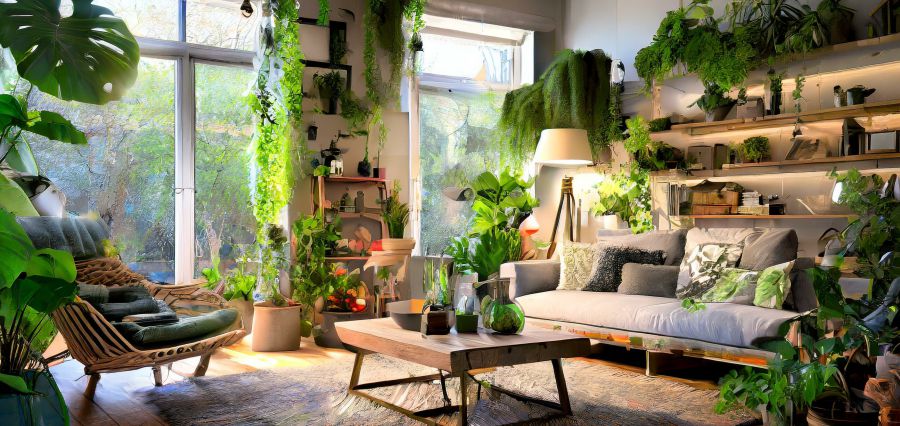Living Essence
For many, a beautifully designed home is the essence of comfortable living. But what if that comfort could extend beyond our walls and contribute to a healthier planet? Modern interior design firms are increasingly recognizing this connection and are emerging as leaders in the movement towards sustainable living.
From Aesthetics to Responsibility: A Holistic Shift
Modern interior design isn’t just about creating beautiful spaces anymore. It’s undergoing a holistic revolution, transforming into a practice deeply rooted in sustainability. This shift is being spearheaded by forward-thinking interior design firms and construction companies who recognize the impact our living spaces have on the environment.
Sustainable Design Principles:
This new approach goes beyond mere aesthetics. Sustainable design prioritizes eco-friendly materials, energy efficiency, and responsible resource management. Here’s how modern design firms are incorporating these principles:
Embracing Eco-Friendly Materials Marvel: A key strategy for these firms is the use of eco-friendly materials. By sourcing sustainable wood, recycled metal, and non-toxic finishes, designers reduce the environmental impact of their projects. These materials not only minimize resource depletion but also contribute to healthier indoor air quality, benefiting the well-being of inhabitants. Sustainable materials like bamboo, recycled glass, and reclaimed wood are replacing conventional options with high environmental impact. These not only look stunning but also boast lower carbon footprints and support responsible forestry practices.
Energy Efficiency Champions: Lighting design plays a crucial role. By incorporating LED fixtures and natural light strategies, designers are minimizing energy consumption. Smart thermostats and water-saving fixtures can further reduce a home’s environmental impact.
Secondhand Chic: Vintage furniture and decor are making a comeback. Designers are finding creative ways to breathe new life into pre-loved pieces, reducing reliance on mass-produced furniture and minimizing waste.
Upcycling and Repurposing: Upcycling and repurposing old furniture and decor elements have become popular trends. Designers creatively transform outdated items into stylish, functional pieces, reducing the need for new materials and minimizing waste. This approach not only adds a unique character to the interiors but also promotes a circular economy.
Smart Home Integration: The integration of smart home technology is another significant advancement. Smart thermostats, lighting systems, and automated shading solutions help optimize energy use, enhancing the sustainability of living spaces. These technologies allow homeowners to monitor and control their energy consumption efficiently.
Locally Sourced: Modern firms are increasingly sourcing materials and furniture from local artisans and businesses. This not only reduces the environmental impact of transportation but also supports the local economy.
Innovative Design Techniques: Modern interior design firms employ innovative techniques to enhance energy efficiency and reduce waste. Incorporating natural light, optimizing space for better airflow, and using energy-efficient lighting and appliances are common practices. These strategies lower energy consumption and create more comfortable living spaces.
Community and Cultural Sensitivity: Modern design firms are also sensitive to the cultural and community aspects of sustainability. By incorporating local materials and collaborating with local artisans, they support local economies and preserve cultural heritage. This practice ensures that sustainability is holistic, benefiting both the environment and the community.
Commitment to Green Certifications: Many leading interior design firms are committed to achieving green certifications such as LEED (Leadership in Energy and Environmental Design). These certifications ensure that the buildings and interiors meet stringent environmental standards, further solidifying the firm’s dedication to sustainable practices.
Educating Clients: Educating clients about the benefits of sustainable living is a crucial part of the process. Designers actively involve clients in the decision-making process, highlighting the long-term benefits of eco-friendly choices. This education fosters a broader cultural shift towards sustainability.
Benefits Beyond the Environment: Sustainable design isn’t just good for the planet; it’s good for you too! Eco-friendly materials often promote better indoor air quality, leading to a healthier living environment. Additionally, the focus on natural light and resource conservation can create a more calming and restorative atmosphere in your home.
Benefits Beyond the Planet
The impact of sustainable design isn’t limited to the environment. It translates to a better living experience for you:
Healthier Homes: Eco-friendly materials often contribute to improved indoor air quality, reducing respiratory issues and allergies.
Natural Light for Wellbeing: Strategically maximizing natural light not only reduces energy consumption but also creates a more calming and restorative atmosphere.
Durability for Long-Term Value: Sustainable construction practices ensure your home is built to last, reducing maintenance costs and enhancing its resale value.
A Collaborative Effort for a Sustainable Future
This revolution in interior design is a collaborative effort between forward-thinking design firms and responsible construction companies. By working together, they are empowering homeowners to make a positive impact on the planet while creating beautiful and healthy living spaces.
The Future of Sustainable Design
Modern interior design firms are essential drivers of sustainable living, leveraging innovative materials, techniques, and technologies to create eco-friendly and health-conscious spaces. Their commitment to sustainability extends beyond design, encompassing education, community involvement, and a dedication to green practices. As these firms continue to lead by example, they pave the way for a more sustainable future in the interior design industry.
As environmental consciousness continues to grow, sustainable design will undoubtedly become the norm in interior design. Modern firms are at the forefront of this movement, offering homeowners the opportunity to create beautiful, functional, and eco-friendly living spaces. By embracing sustainable practices, these designers are helping to shape a future where style meets responsibility, ensuring a comfortable living experience for us and a healthier planet for generations to come.


